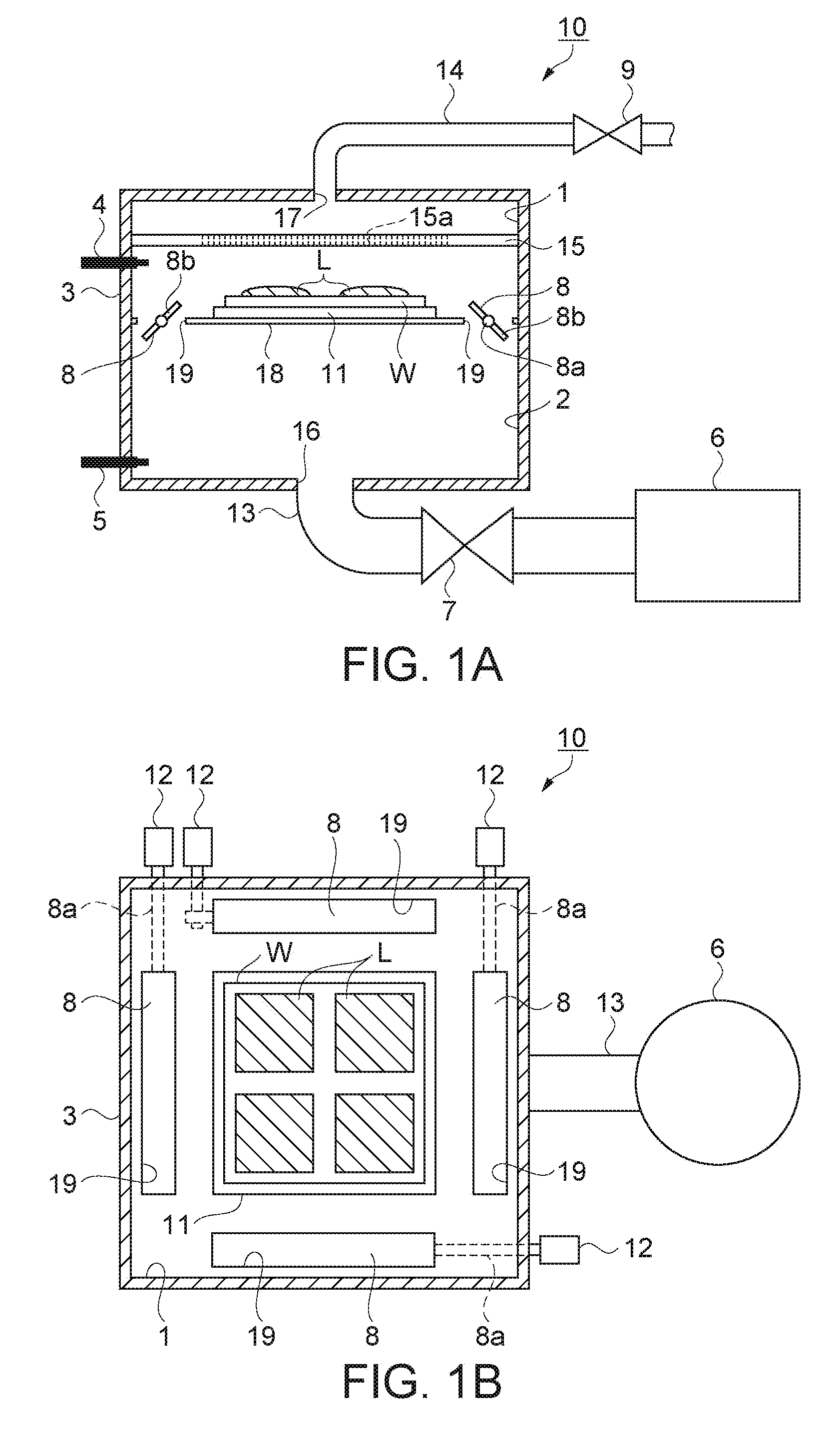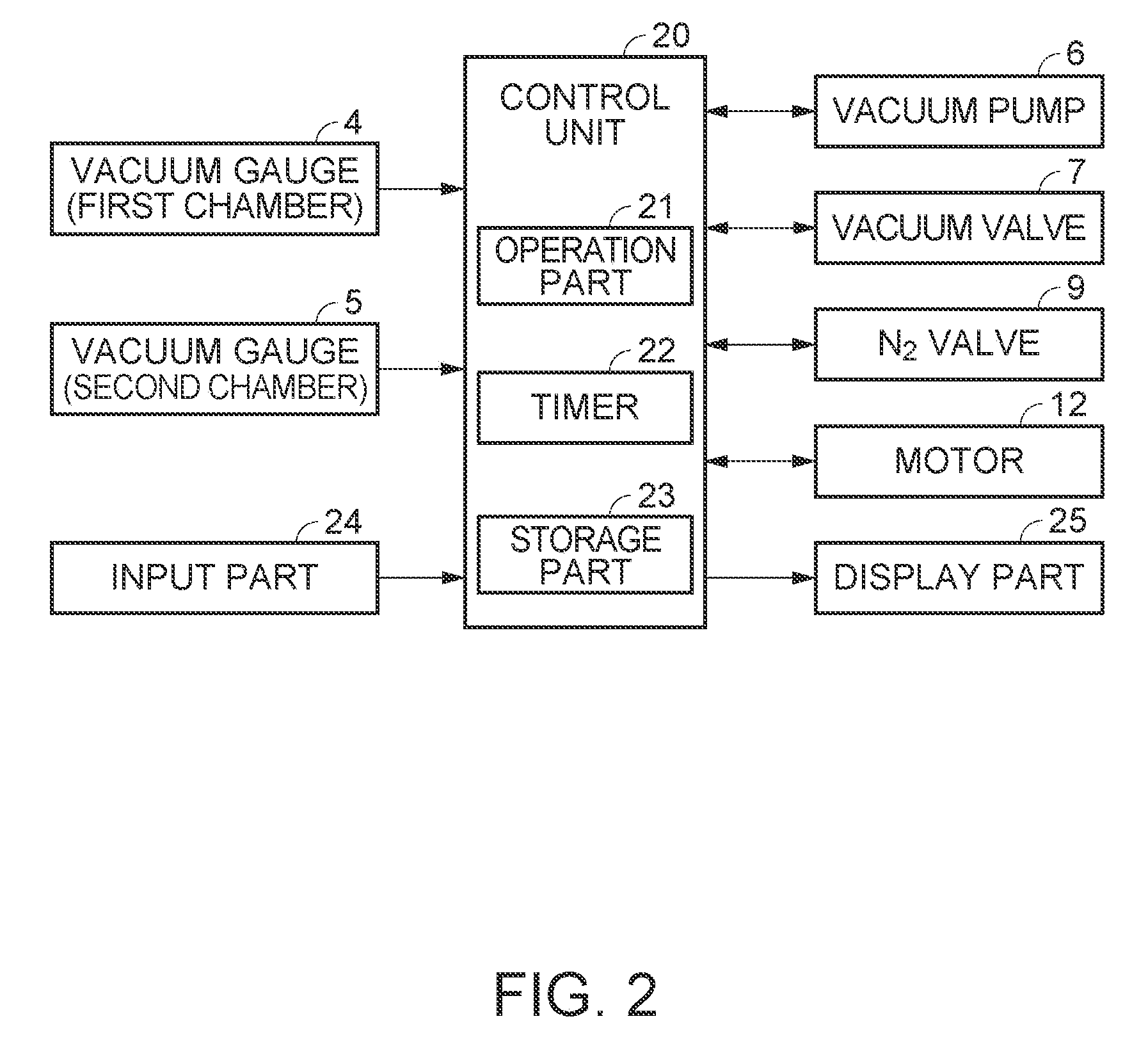Reduced-pressure drying apparatus
a drying apparatus and reducing pressure technology, applied in drying machines, lighting and heating apparatus, furniture, etc., can solve the problems of inability to secure the versatility of the apparatus, the film thickness in the plane is affected by the difference in drying rate, and the difficulty of drying liquid, so as to reduce the unevenness of the film thickness on the work surface, reduce the pressure, and reduce the effect of pressur
- Summary
- Abstract
- Description
- Claims
- Application Information
AI Technical Summary
Benefits of technology
Problems solved by technology
Method used
Image
Examples
first embodiment
[0042]FIGS. 1A and 1B are schematic views showing a structure of a reduced-pressure drying apparatus according to a first embodiment of the invention. FIG. 1A is a perspective schematic view of the apparatus from the side to the inside of the apparatus. FIG. 1B is a perspective schematic view of the apparatus from the top side to the inside of the apparatus. As shown in FIG. 1A, a substrate W which is work to which liquid L is applied is provided in a chamber 3 of a reduced-pressure drying apparatus 10. The liquid L includes a film forming material that is an alignment film forming material in this embodiment. The reduced-pressure drying apparatus is equipment in which a solvent of the liquid L is evaporated and dried under a reduced pressure.
[0043]The chamber 3 includes a first chamber 1 which is illustrated in the upper side in FIG. 1A and a second chamber 2 which is illustrated in the lower side of the figure. A partition wall 18 divides the chamber 3 in such a way that the volum...
second embodiment
[0082]FIGS. 4A and 4B are schematic views showing a structure of a reduced-pressure drying apparatus according to a second embodiment of the invention. FIG. 4A is a perspective schematic view from the side to the inside of the apparatus. FIG. 4B is a perspective schematic view from the top side to the inside of the apparatus.
[0083]As shown in FIG. 4A, a reduced-pressure drying apparatus 30 has a chamber 33 and a vacuum pump 36. The chamber 33 includes a first chamber 31 and a second chamber 32 which is provided so as to surround the first chamber. The substrate W to which liquid L is applied is provided in the first chamber 31. The vacuum pump 36 can depressurize the second chamber 32.
[0084]The first chamber 31 is formed by parting the chamber 33 with a partition wall 48 which is provided in the bottom of the chamber 33 and has a box shape. A stage 41 on which the substrate W is placed is provided on the bottom of the first chamber 31. A communicating opening 49 whose size correspon...
third embodiment
[0091]FIG. 5 is a schematic view showing a structure of a reduced-pressure drying apparatus according to a third embodiment of the invention. FIG. 5 is a perspective schematic view from the side to the inside of the apparatus.
[0092]As shown in FIG. 5, a reduced-pressure drying apparatus 50 according to the third embodiment has a chamber 53, a vacuum pump 56 and a partition wall 68. The chamber 3 includes a first chamber 51 in which the substrate W to which the liquid L is applied is placed and a second chamber 52. The vacuum pump 56 can decrease the pressure in the second chamber 52. The partition wall 68 divides the chamber 3 into the first chamber 51 and the second chamber 52. The partition wall 68 is movable along the inner wall of the chamber 53. A vacuum gauge 54 which measures a pressure reducing state in the first chamber 51 and a vacuum gauge 55 which measures a pressure reducing state in the second chamber 52 are also provided.
[0093]A table 61 on which the substrate W is pl...
PUM
 Login to View More
Login to View More Abstract
Description
Claims
Application Information
 Login to View More
Login to View More - R&D
- Intellectual Property
- Life Sciences
- Materials
- Tech Scout
- Unparalleled Data Quality
- Higher Quality Content
- 60% Fewer Hallucinations
Browse by: Latest US Patents, China's latest patents, Technical Efficacy Thesaurus, Application Domain, Technology Topic, Popular Technical Reports.
© 2025 PatSnap. All rights reserved.Legal|Privacy policy|Modern Slavery Act Transparency Statement|Sitemap|About US| Contact US: help@patsnap.com



